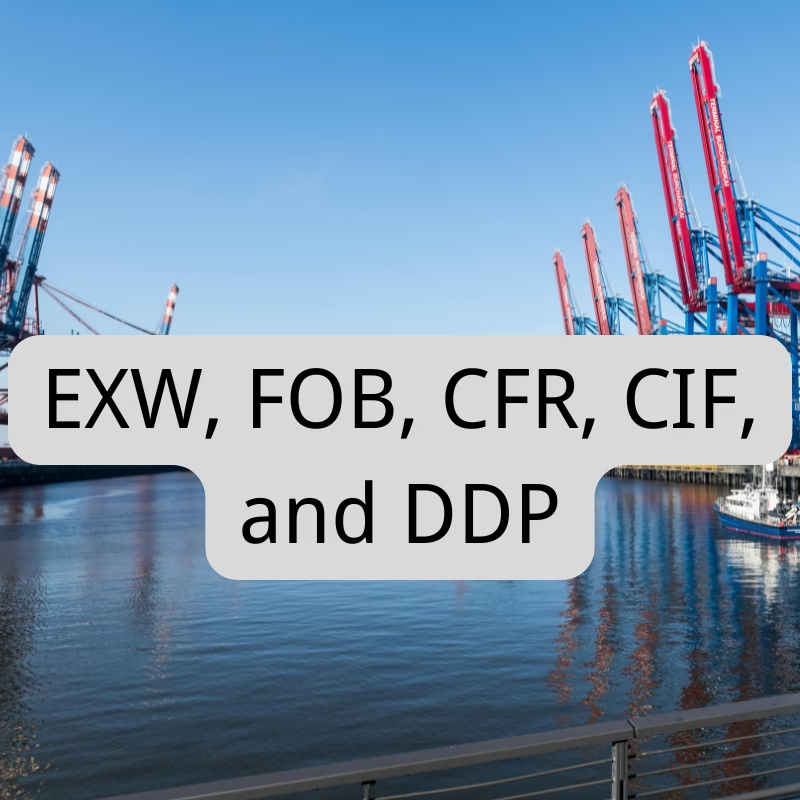Comprehensive guide to EXW, FOB, CFR, CIF, and DDP in international trade—differences, risk allocation, 2025 updates, and real-world case studies.
In global trade, clarity on responsibilities, costs, and risks between buyers and sellers is essential. The Incoterms® rules, published by the International Chamber of Commerce (ICC), provide a standardized framework to avoid disputes and streamline contracts. Among the 11 Incoterms, five are particularly common in practice: EXW, FOB, CFR, CIF, and DDP.
This article explores their differences, risk allocation, cost responsibilities, and practical applications, with references to 2025 trade updates and case studies.
Overview of the Five Key Incoterms
| Term | Full Form | Delivery Point | Seller’s Responsibility | Buyer’s Responsibility | Risk Transfer |
|---|---|---|---|---|---|
| EXW | Ex Works | Seller’s premises | Provide goods & invoice | All transport, export/import clearance, insurance | At seller’s premises |
| FOB | Free On Board | On board vessel at port of shipment | Export clearance, delivery to port, loading | Freight, insurance, import clearance | Once goods are loaded |
| CFR | Cost and Freight | Destination port | Export clearance, freight to destination port | Insurance, import clearance, local delivery | Once goods are loaded |
| CIF | Cost, Insurance & Freight | Destination port | Export clearance, freight, minimum insurance | Import clearance, local delivery | Once goods are loaded |
| DDP | Delivered Duty Paid | Buyer’s premises (or agreed destination) | All costs: transport, insurance, export & import clearance, duties | Only to receive goods | At buyer’s premises |
Detailed Analysis of Each Term
1. EXW (Ex Works)
- Seller’s role: Minimal—only makes goods available at factory/warehouse.
- Buyer’s role: Handles everything from pickup, export clearance, freight, insurance, to import duties.
- Risk: Transfers immediately at seller’s premises.
- Case Example (2024): A U.S. buyer sourcing machinery from Shenzhen under EXW faced delays because Chinese law requires a local entity to file export customs. Without a local agent, the buyer incurred $8,000 in storage fees before resolving clearance.
2. FOB (Free On Board)
- Seller’s role: Handles export clearance, delivers goods to port, loads onto vessel.
- Buyer’s role: Pays for freight, insurance, and import clearance.
- Risk: Transfers once goods are loaded on the vessel.
- Case Example (2025): In the Shanghai–Los Angeles shipping lane, freight rates surged 35% in Q1 2025 due to Red Sea disruptions. Buyers under FOB bore the brunt of these cost increases, while sellers were unaffected.
3. CFR (Cost and Freight)
- Seller’s role: Pays for freight to destination port.
- Buyer’s role: Pays for insurance, import clearance, and inland delivery.
- Risk: Transfers once goods are loaded at origin port.
- Risk Note: If the seller delays sending shipping documents, the buyer may miss the insurance window.
- Case Example: In 2023, a Brazilian importer of steel coils under CFR terms suffered $120,000 in cargo damage during transit. Since the seller had no obligation to insure, the buyer had to absorb the loss.
4. CIF (Cost, Insurance & Freight)
- Seller’s role: Same as CFR, but also must provide minimum insurance coverage.
- Buyer’s role: Still responsible for import clearance and local delivery.
- Risk: Transfers once goods are loaded, despite seller paying insurance.
- Insurance Caveat: Sellers often purchase only basic coverage (Institute Cargo Clauses C), which excludes many risks. Buyers should negotiate for “All Risks” coverage.
- Case Example (2025): A European SME importing textiles under CIF terms discovered that the seller’s insurance only covered fire and sinking, not theft. After a container theft in Rotterdam, the buyer lost €40,000.
5. DDP (Delivered Duty Paid)
- Seller’s role: Maximum responsibility—covers transport, insurance, export & import clearance, duties, and delivery to buyer’s door.
- Buyer’s role: Simply receives the goods.
- Risk: Transfers only upon delivery at the agreed destination.
- Case Example (2024): A Korean electronics exporter selling under DDP to Germany underestimated EU anti-dumping duties on certain components. The unexpected tariff increase wiped out 15% of profit margins, as the seller had to absorb the cost.
Risk Allocation and Cost Responsibilities
Risk Transfer Points
- EXW: At seller’s premises (earliest transfer).
- FOB/CFR/CIF: At loading on vessel.
- DDP: At buyer’s premises (latest transfer).
Cost Allocation Snapshot
- EXW: Buyer pays everything.
- FOB: Seller pays until loading; buyer pays freight & beyond.
- CFR: Seller pays freight; buyer pays insurance & beyond.
- CIF: Seller pays freight + minimum insurance; buyer pays beyond.
- DDP: Seller pays everything, including duties.
Latest Trade Trends (2025)
- Global container freight rates remain volatile, with Asia–Europe routes averaging $4,200 per FEU in mid-2025, up 18% year-on-year.
- Insurance claims in maritime trade rose 12% in 2024, largely due to theft and weather-related incidents.
- DDP usage is increasing in cross-border e-commerce, as sellers seek to provide “Amazon-style” delivery experiences.
Choosing the Right Term
- For new importers: CIF or DDP reduces complexity.
- For experienced buyers: EXW or FOB offers more control and cost savings.
- For high-value goods: CIF with extended insurance or FOB with buyer-arranged comprehensive insurance is safer.
- For politically unstable regions: Avoid DDP due to unpredictable tariffs; consider DAP or FCA instead.
Q&A: Common Questions About EXW, FOB, CFR, CIF, and DDP
Conclusion
Understanding the differences and risk allocations of EXW, FOB, CFR, CIF, and DDP is critical for successful international trade. Each term shifts responsibility and cost in unique ways, and the right choice depends on experience level, product type, and market conditions. With freight volatility and regulatory changes in 2025, businesses must carefully negotiate Incoterms to protect margins and minimize disputes.
Would you like me to also create a visual infographic (cost & risk allocation timeline) for these five Incoterms? It would make the article more engaging and easier for readers to digest.
A Guide to China’s Top 5 Airports 2025
Soaring Through the Middle Kingdom: A Guide to China’s Top 5 Airports 2025, China’s meteoric…
The Ultimate Guide to Sourcing & Shipping Christmas Ornaments from China
The Ultimate Guide to Sourcing & Shipping Christmas Ornaments from China. The holiday season is…
Decoding Shunde: The Ultimate Guide to the World’s Appliance Capital
Decoding Shunde, If you’ve ever turned on a microwave, blended a smoothie, or adjusted your…






Pingback: Explanation of 13 trade terms
Pingback: IOSS, OSS, VAT Number, and EORI Explained